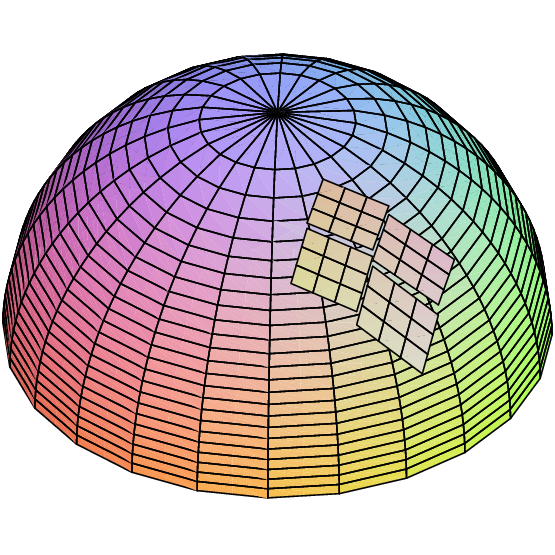We next seek to compute the area of a surface above (or below) a region in the $x$-$y$ plane. How might we approximate this? We start, as usual, by dividing the region into a grid of small rectangles. We want to approximate the area of the surface above one of these small rectangles. The area is very close to the area of the tangent plane above the small rectangle. If the tangent plane just happened to be horizontal, of course the area would simply be the area of the rectangle. For a typical plane, however, the area is the area of a parallelogram, as indicated in figure 17.4.1. Note that the area of the parallelogram is obviously larger the more "tilted'' the tangent plane. In the interactive figure you can see that viewed from above the four parallelograms exactly cover a rectangular region in the $x$-$y$ plane.
Now recall a curious fact: the area of a parallelogram can be computed as the cross product of two vectors (section 14.4). We simply need to acquire two vectors, parallel to the sides of the parallelogram and with lengths to match. But this is easy: in the $x$ direction we use the tangent vector we already know, namely $\langle 1,0,f_x\rangle$ and multiply by $\Delta x$ to shrink it to the right size: $\langle \Delta x,0,f_x\Delta x\rangle$. In the $y$ direction we do the same thing and get $\langle 0,\Delta y,f_y\Delta y\rangle$. The cross product of these vectors is $\langle f_x,f_y,-1\rangle\,\Delta x\,\Delta y$ with length $\ds\sqrt{f_x^2+f_y^2+1}\,\Delta x\,\Delta y$, the area of the parallelogram. Now we add these up and take the limit, to produce the integral $$\int_{x_0}^{x_1}\int_{y_0}^{y_1} \sqrt{f_x^2+f_y^2+1}\,dy\,dx.$$ As before, the limits need not be constant.
Example 17.4.1 We find the area of the hemisphere $\ds z=\sqrt{1-x^2-y^2}$. We compute the derivatives $$f_x={-x\over\sqrt{1-x^2-y^2}} \qquad f_y={-y\over\sqrt{1-x^2-y^2}},$$ and then the area is $$\int_{-1}^{1}\int_{-\sqrt{1-x^2}}^{\sqrt{1-x^2}} \sqrt{ {x^2\over1-x^2-y^2}+{y^2\over1-x^2-y^2}+1}\,dy\,dx.$$ This is a bit on the messy side, but we can use polar coordinates: $$ \int_{0}^{2\pi}\int_{0}^{1} \sqrt{ {1\over1-r^2}}\;r\,dr\,d\theta.$$ This integral is improper, since the function is undefined at the limit $1$. We therefore compute $$\lim_{a\to1^-}\int_{0}^{a} \sqrt{ {1\over1-r^2}}\;r\,dr=\lim_{a\to1^-}-\sqrt{1-a^2}+1=1,$$ using the substitution $u=1-r^2$. Then the area is $$\int_{0}^{2\pi}1\;d\theta=2\pi.$$ You may recall that the area of a sphere of radius $r$ is $4\pi r^2$, so half the area of a unit sphere is $(1/2)4\pi=2\pi$, in agreement with our answer. (Alternately, we can view this calculation as proving that the formula for the area of a sphere is correct.) $\square$
Exercises 17.4
Here is a Sage cell if you'd like to use it.
Ex 17.4.1 Find the area of the surface of a right circular cone of height $h$ and base radius $a$. (answer)
Ex 17.4.2 Find the area of the portion of the plane $z=mx$ inside the cylinder $x^2+y^2=a^2$. (answer)
Ex 17.4.3 Find the area of the portion of the plane $x+y+z=1$ in the first octant. (answer)
Ex 17.4.4 Find the area of the upper half of the cone $x^2+y^2=z^2$ inside the cylinder $x^2+y^2-2x = 0$. (answer)
Ex 17.4.5 Find the area of the upper half of the cone $x^2+y^2=z^2$ above the interior of one loop of $r=\cos(2\theta)$. (answer)
Ex 17.4.6 Find the area of the upper hemisphere of $x^2+y^2+z^2=1$ above the interior of one loop of $r=\cos(2\theta)$. (answer)
Ex 17.4.7 The plane $ax+by+cz=d$ cuts a triangle in the first octant provided that $a, b, c$ and $d$ are all positive. Find the area of this triangle. (answer)
Ex 17.4.8 Find the area of the portion of the cone $x^2+y^2 = 3z^2$ lying above the $xy$ plane and inside the cylinder $x^2+y^2 = 4y$. (answer)

